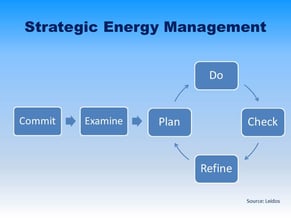There’s a new phrase gaining popularity in the energy efficiency and cost saving arena. It’s really a new name for something we’ve been advocating for all along.
Strategic Energy Management, or SEM.
SEM combines a philosophy of continuous performance improvement with energy efficiency practices. More than a process, it encourages a culture of continuous co-operation across disciplines.
“Instead of managing energy saving projects one by one, SEM allows you to manage energy in a coordinated and strategic way across your organization,” notes NYSERDA, the New York State Energy Research and Development Authority.
In their 2018 Energy Efficiency Indicator survey, Johnson Controls found that well over half of U.S. and global organizations “plan to increase investment in energy efficiency in the next year.” According to EnergyStar, SEM provides “the processes and systems needed to incorporate energy considerations and energy management into daily operations.” Its simplicity makes it universally appealing.
- Get a commitment

- Examine your opportunities for improvement
- Make a plan
- Implement (do) the plan
- Check on your progress (track)
- Refine the plan
- Go back and do it over and over again
Here are three things to know about SEM before embarking on this path. It will work if you are dedicated to the following:
- Commit for the long term.
In a section on Data-Driven, Strategic Energy Management, The U.S. Department of Energy (DOE), Office of Energy Efficiency and Renewable Energy says “Strategic energy management is a long-term approach to energy efficiency that includes setting goals, tracking progress, and reporting results.”
To be effective, you have to make that long-term commitment. You learn and implement the cycle, then repeat and repeat and repeat for best results - continuous results.
- Make an investment.
As the saying goes, it takes money to make money. True, many buildings can benefit from low- and no-cost improvements in HVAC systems operations, but you have to know what the improvements are and how to make them for best results. That’s a great start, but long-term, continuous energy efficiency improvement requires more. You need the starting data and the tracking data. Be willing to invest the time and money for an energy audit (see What’s Preventing You From Having an Energy Audit?) and tracking systems, like Building Energy Management Information Systems (BEMIS), and the training required to get the most out of them.
Today many creative financing options exist to help you make the most important energy efficiency improvements. Many states offer PACE financing, or consider applying for rebates, tax credits, deductions and other incentives to help reduce the overall amount needed to be financed. A knowledgeable consultant can help with that so your staff doesn’t have to do the research or spend time figuring out paperwork when they have other obligations.
Most importantly, invest in your team. Training and support will go far toward making SEM a long-term success. There are many resources available for teams, such as DOE’s Teaming Up to Save Energy Guide.
- See the bigger picture.
SEM forces your organization to get out of silos and work across departments. Yes, you very likely will realize some quick “wins.” Over time they may become more incremental, but no less valuable. So keep going.
Short and long-term goal setting will guide the process. Consider your goals on multiple levels: internal, external, community, and world.
Here are a few additional points to consider:
- SEM works in both public and private sector
Public buildings, educational, manufacturing, industrial and commercial buildings can all benefit from effective SEM. Not only can SEM increase value of a commercial property, DOE says public buildings “benefit as SEM reduces costs across many end uses, institutionalizes practices to sustain long-term savings, and can serve as a model for the private sector.”
- Build your team both internally and externally
You probably have a very talented staff. They may or may not have all the skills to make SEM successful. Don’t be afraid to call on outside help for energy audits, management training, help with financing, etc.
- Share, share, share
One of the best benefits of SEM and improving your building energy efficiency, besides improving your bottom line, is improving your image. Take the opportunity to blow your own horn. Your community will want to know, and your staff will feel great about what they are doing. A little public relations and public recognition helps build brand and company loyalty.




